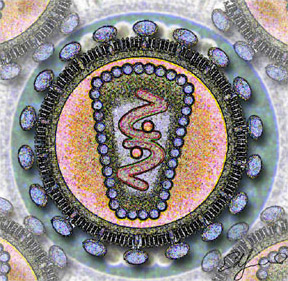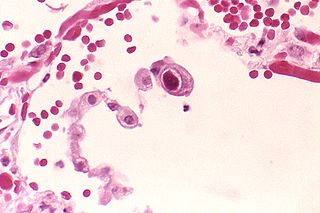Вирус герпеса человека 7 типа
| Вирус герпеса человека 7 типа | |
|---|---|
| Научная классификация | |
Реалм: Царство: Тип: Peploviricota Класс: Herviviricetes Порядок: Семейство: Подсемейство: Род: Вид: Вирус герпеса человека 7 типа | |
| Международное научное название | |
| Human betaherpesvirus 7 | |
| Синонимы | |
| |
| Группа по Балтимору | |
| I: дцДНК-вирусы | |
Вирус герпеса человека 7 типа[3] или герпесвирус человека тип 7[4] (ВГЧ-7, англ. Human betaherpesvirus 7, ранее англ. Human herpesvirus 7) — вид вирусов из семейства герпесвирусов, способный инфицировать человека. Вирус относится к подсемейству бетагерпесвирусов, наряду с ВГЧ-6 и цитомегаловирусом[5][6]. ВГЧ-7 часто действует совместно с ВГЧ-6, вместе они относятся к роду Roseolovirus[7]. Вирус впервые был изолирован в 1990 году из CD4+ Т-лимфоцитов периферической крови[8]. В 2016 году был переименован для отображения подсемейства, к которому относится[9].
Вирология
Структура
Зрелые вирусные частицы составляют около 170 нм в диаметре[10].
Геном ВГЧ-7 близок к геному ВГЧ-6, однако меньше его приблизительно на 10%[11]; имеет около 145 тысяч пар оснований[12]. Есть несколько ключевых различий в геноме ВГЧ-6 и ВГЧ-7, однако их значение для репликации пока неизвестно[12].
Клеточные эффекты
ВГЧ-7 присутствует в основном в CD4+ Т-клетках[13], однако только в определенных их типах[14][15][16]. Чтобы попасть в Т-клетку, ВГЧ-7, в отличие от ВГЧ-6, задействует CD4, и, возможно, другие гликопротеины поверхности клетки[17].
Приблизительно через неделю после инфекции ВГЧ-7, вирус начинает подавлять транскрипцию CD4[18]. Поскольку ВИЧ также использует CD4 в качестве рецептора, инфекция ВГЧ-7 может оказывать влияние на ВИЧ-инфекцию[19], однако конкретные эффекты такого влияния пока неясны[12]. Инфекция ВГЧ-7 может реактивировать ВГЧ-6-инфекцию[20].
ВГЧ-7 может иметь также другие эффекты на клетки. Среди них синцитий[21][8], случайный апоптоз[22], поддержка латентной инфекции[23] и влияние на уровень определённых цитокинов[24][25].
Эпидемиология
Более 95 % взрослых инфицированы и имеют иммунитет против ВГЧ-7[26], и более 75 % перенесли инфекцию в возрасте до 6 лет[27]. Первичное инфицирование происходит, как правило, в возрасте от 2 до 5 лет, то есть позже инфицирования ВГЧ-6[28].
Диагностика и лечение
У взрослых, специфичные эффекты ВГЧ-7, отдельные от ВГЧ-6, изучены недостаточно[5]. Присутствие ВГЧ-7 может быть определено методом LAMP (англ. loop-mediated isothermal amplification)[29] и риал-тайм ПЦР[30].
Специфичного лечения инфекции ВГЧ-7 не существует, могут использоваться противовирусные препараты широкого спектра, в частности валацикловир и ганцикловир[31].
Примечания
- ↑ Таксономия вирусов (англ.) на сайте Международного комитета по таксономии вирусов (ICTV).
- ↑ ICTV Taxonomy History for Human betaherpesvirus 7 Архивная копия от 10 августа 2016 на Wayback Machine на сайте ICTV (англ.) (Дата обращения: 27 июня 2016).
- ↑ Никольский М. А. Вирус герпеса человека 7 типа // Инфекция и иммунитет. — 2013. — Т. 3, № 1. — С. 15—20. — ISSN 2313-7398. — doi:10.15789/2220-7619-2013-1-15-20.
- ↑ Атлас по медицинской микробиологии, вирусологии и иммунологии : Учебное пособие для студентов медицинских вузов / Под ред. А. А. Воробьева, А. С. Быкова. — М. : Медицинское информационное агентство, 2003. — С. 109. — ISBN 5-89481-136-8.
- ↑ 1 2 Other herpesviruses: HHV-6, HHV-7, HHV-8, HSV-1 and -2, VZV. (англ.) // American journal of transplantation : official journal of the American Society of Transplantation and the American Society of Transplant Surgeons. — 2004. — Vol. 4 Suppl 10. — P. 66—71. — doi:10.1111/j.1600-6135.2004.00697.x. — PMID 15504215.
- ↑ Widen B. F., Lowings J. P., Belak S., Banks M. Development of a PCR system for porcine cytomegalovirus detection and determination of the putative partial sequence of its DNA polymerase gene. (англ.) // Epidemiology and infection. — 1999. — Vol. 123, no. 1. — P. 177—180. — PMID 10487654.
- ↑ Ongrádi J., Kövesdi V., Kováts E. Human herpesvirus 7 // Orvosi hetilap. — 2010. — Vol. 151, № 16. — P. 645—651. — doi:10.1556/OH.2010.28856. — PMID 20353917.
- ↑ 1 2 Frenkel N., Schirmer E. C., Wyatt L. S., Katsafanas G., Roffman E., Danovich R. M., June C. H. Isolation of a new herpesvirus from human CD4+ T cells. (англ.) // Proceedings of the National Academy of Sciences of the United States of America. — 1990. — Vol. 87, no. 2. — P. 748—752. — PMID 2153965.
- ↑ Davison A., Pellett P., Stewart J. Rename species in the family Herpesviridae to incorporate a subfamily designation : [англ.] : [арх. 23 июня 2016] // ICTVonline. — Code assigned: 2015.010aD. — 2015. — 5 p.
- ↑ Klussmann J. P., Krueger E., Sloots T., Berneman Z., Arnold G., Krueger G. R. Ultrastructural study of human herpesvirus-7 replication in tissue culture. (англ.) // Virchows Archiv : an international journal of pathology. — 1997. — Vol. 430, no. 5. — P. 417—426. — PMID 9174632.
- ↑ Nicholas J. Determination and analysis of the complete nucleotide sequence of human herpesvirus. (англ.) // Journal of virology. — 1996. — Vol. 70, no. 9. — P. 5975—5989. — PMID 8709220.
- ↑ 1 2 3 Tremblay, Cecile (January 2, 2008). Hirsch, Martin S; McGovern, Barbara H, eds. "Human herpesvirus 7 infection". UpToDate.
- ↑ Katsafanas G. C., Schirmer E. C., Wyatt L. S., Frenkel N. In vitro activation of human herpesviruses 6 and 7 from latency. (англ.) // Proceedings of the National Academy of Sciences of the United States of America. — 1996. — Vol. 93, no. 18. — P. 9788—9792. — PMID 8790409.
- ↑ Berneman Z. N., Ablashi D. V., Li G., Eger-Fletcher M., Reitz M. S. Jr., Hung C. L., Brus I., Komaroff A. L., Gallo R. C. Human herpesvirus 7 is a T-lymphotropic virus and is related to, but significantly different from, human herpesvirus 6 and human cytomegalovirus. (англ.) // Proceedings of the National Academy of Sciences of the United States of America. — 1992. — Vol. 89, no. 21. — P. 10552—10556. — PMID 1332051.
- ↑ Mirandola P., Secchiero P., Pierpaoli S., Visani G., Zamai L., Vitale M., Capitani S., Zauli G. Infection of CD34(+) hematopoietic progenitor cells by human herpesvirus 7 (HHV-7). (англ.) // Blood. — 2000. — Vol. 96, no. 1. — P. 126—131. — PMID 10891440.
- ↑ Yasukawa M., Inoue Y., Ohminami H., Sada E., Miyake K., Tohyama T., Shimada T., Fujita S. Human herpesvirus 7 infection of lymphoid and myeloid cell lines transduced with an adenovirus vector containing the CD4 gene. (англ.) // Journal of virology. — 1997. — Vol. 71, no. 2. — P. 1708—1712. — PMID 8995705.
- ↑ Secchiero P., Sun D., De Vico A. L., Crowley R. W., Reitz M. S. Jr., Zauli G., Lusso P., Gallo R. C. Role of the extracellular domain of human herpesvirus 7 glycoprotein B in virus binding to cell surface heparan sulfate proteoglycans. (англ.) // Journal of virology. — 1997. — Vol. 71, no. 6. — P. 4571—4580. — PMID 9151851.
- ↑ Hall C. B. Human herpesviruses at sixes, sevens, and more. (англ.) // Annals of internal medicine. — 1997. — Vol. 127, no. 6. — P. 481—483. — PMID 9313006.
- ↑ Lusso P., Secchiero P., Crowley R. W., Garzino-Demo A., Berneman Z. N., Gallo R. C. CD4 is a critical component of the receptor for human herpesvirus 7: interference with human immunodeficiency virus. (англ.) // Proceedings of the National Academy of Sciences of the United States of America. — 1994. — Vol. 91, no. 9. — P. 3872—3876. — PMID 7909607.
- ↑ Tanaka-Taya K., Kondo T., Nakagawa N., Inagi R., Miyoshi H., Sunagawa T., Okada S., Yamanishi K. Reactivation of human herpesvirus 6 by infection of human herpesvirus 7. (англ.) // Journal of medical virology. — 2000. — Vol. 60, no. 3. — P. 284—289. — PMID 10630960.
- ↑ Secchiero P., Berneman Z. N., Gallo R. C., Lusso P. Biological and molecular characteristics of human herpesvirus 7: in vitro growth optimization and development of a syncytia inhibition test. (англ.) // Virology. — 1994. — Vol. 202, no. 1. — P. 506—512. — doi:10.1006/viro.1994.1371. — PMID 8009865.
- ↑ Secchiero P., Flamand L., Gibellini D., Falcieri E., Robuffo I., Capitani S., Gallo R. C., Zauli G. Human Herpesvirus 7 induces CD4(+) T-cell death by two distinct mechanisms: necrotic lysis in productively infected cells and apoptosis in uninfected or nonproductively infected cells. (англ.) // Blood. — 1997. — Vol. 90, no. 11. — P. 4502—4512. — PMID 9373261.
- ↑ Menegazzi P., Galvan M., Rotola A., Ravaioli T., Gonelli A., Cassai E., Di Luca D. Temporal mapping of transcripts in human herpesvirus-7. (англ.) // The Journal of general virology. — 1999. — Vol. 80 ( Pt 10). — P. 2705—2712. — doi:10.1099/0022-1317-80-10-2705. — PMID 10573164.
- ↑ Atedzoé B. N., Menezes J., D'Addario M., Xu J., Ongradi J., Ahmad A. Modulatory effects of human herpes virus-7 on cytokine synthesis and cell proliferation in human peripheral blood mononuclear cell cultures. (англ.) // Journal of leukocyte biology. — 1999. — Vol. 66, no. 5. — P. 822—828. — PMID 10577515.
- ↑ Atedzoe B. N., Ahmad A., Menezes J. Enhancement of natural killer cell cytotoxicity by the human herpesvirus-7 via IL-15 induction. (англ.) // Journal of immunology (Baltimore, Md. : 1950). — 1997. — Vol. 159, no. 10. — P. 4966—4972. — PMID 9366423.
- ↑ Clark D. A., Freeland M. L., Mackie L. K., Jarrett R. F., Onions D. E. Prevalence of antibody to human herpesvirus 7 by age. (англ.) // The Journal of infectious diseases. — 1993. — Vol. 168, no. 1. — P. 251—252. — PMID 8390545.
- ↑ Cermelli C., Fabio G., Montorsi M., Sabbatini A. M., Portolani M. Prevalence of antibodies to human herpesviruses 6 and 7 in early infancy and age at primary infection. (англ.) // The new microbiologica. — 1996. — Vol. 19, no. 1. — P. 1—8. — PMID 8673847.
- ↑ Yoshikawa T. Human herpesvirus-6 and -7 infections in transplantation. (англ.) // Pediatric transplantation. — 2003. — Vol. 7, no. 1. — P. 11—17. — PMID 12581322.
- ↑ Yoshikawa T., Ihira M., Akimoto S., Usui C., Miyake F., Suga S., Enomoto Y., Suzuki R., Nishiyama Y., Asano Y. Detection of human herpesvirus 7 DNA by loop-mediated isothermal amplification. (англ.) // Journal of clinical microbiology. — 2004. — Vol. 42, no. 3. — P. 1348—1352. — PMID 15004116.
- ↑ Tanaka T., Kogawa K., Sasa H., Nonoyama S., Furuya K., Sato K. Rapid and simultaneous detection of 6 types of human herpes virus (herpes simplex virus, varicella-zoster virus, Epstein-Barr virus, cytomegalovirus, human herpes virus 6A/B, and human herpes virus 7) by multiplex PCR assay. (англ.) // Biomedical research (Tokyo, Japan). — 2009. — Vol. 30, no. 5. — P. 279—285. — PMID 19887724.
- ↑ Wang F. Z., Pellett P. E. HHV-6A, 6B, and 7: immunobiology and host response (англ.). — 2007. — PMID 21348133.
Литература
- Arvin, Ann; Whitley, Richard. Part III.4 HHV-6A, 6B, and 7 // Human herpesviruses : biology, therapy, and immunoprophylaxis. — Cambridge: Cambridge University Press, 2007. — С. 831—882. — ISBN 978-0-521-82714-0. — doi:10.1017/CBO9780511545313.














